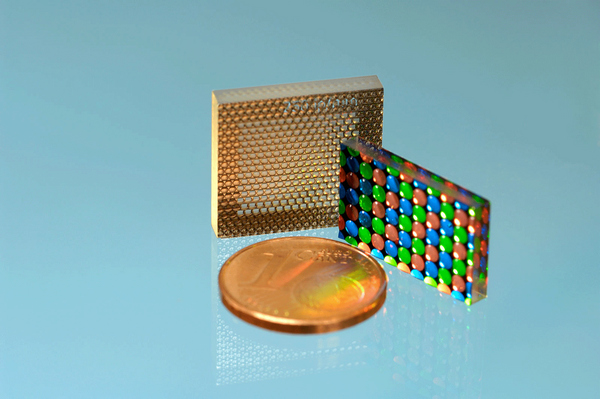The logo glows above the overhang of the wall and ledge of the large office building, immediately identifying the enterprise hidden behind the façade to passersby. Made possible by a projector throwing up a suitable slide onto the wall. However, what works well on flat projection surfaces is fraught with difficulties for curved or uneven surfaces like a façade, however. To achieve sufficient sharpness and depth of field, the aperture must be closed down. But the smaller this opening, the less brightness is achieved – just like with cameras. There is a way around this problem using a laser. Scanning mirrors can direct the laser light so the desired image is created. This process has its drawbacks, however. The setup is complicated and expensive.
 |
|
Micro-optical array projectors: Double-sided lens array with buried slide array (left) and lens array with buried color filters for LCD micro-imager (right). (Photo courtesy of Fraunhofer IOF) |
Sharpness and brightness at the same time
Researchers from the Fraunhofer Institute for Applied Optics and Precision Engineering IOF in Jena, Germany, have applied a proven approach used with cameras. “We close the aperture down to 0.8 mm and thereby attain huge depth of field,” IOF scientist Dr. Peter Schreiber divulges. But in contrast to solutions used up to now, the image projected by IOF is bright. “We create the desired brightness by placing several microprojectors beside one another – known as an array.” To make a long story short, the light from the individual devices is additive – if the image is supposed to brighter, you simply increase the number of projection elements.
The projector can be up to ten by10 centimeters in size for instance, while its thickness is about a centimeter – independent of the number of projectors. “While the exit aperture in today’s projectors is round, we can construct whatever aperture shape we want,” says Schreiber. That means the projector can cast bright and sharp images on a screen of any curvature while possessing its own shape – a logo, for instance – that itself resembles an image. The projector in the shape of a company logo could be mounted on a reception area wall, for example, while at the same time projecting an image on the opposite wall.
Assembled like pieces of a mosaic
If you look more closely at the projector, you see that it consists of numerous 1 cm x 1 cm elements resembling a mosaic. And within each of these elements in turn, there is a single LED and more than a hundred micro-projectors – i.e. a self-contained micro-slide projector with micro-illumination and micro-projection lenses. However, the researchers do not manufacture these micro-projectors individually, but instead as arrays. They overlay the slide array with the lens arrays. “We can use this building block to work with different screen geometries and projection distances,” explains Schreiber. In addition, the optical array has a further advantage: if the geometry of the projection surface or the projection distance change, it is no longer necessary to reconfigure the entire optical system as before, but instead only just the slide array. The optical array itself remains unchanged.
Rapid projection rates
While high-speed cameras can take up to ten-thousand images per second, conventional projectors are slow. They can only reproduce about one-hundred images per second. This difference can lead to problems, since a rate of a hundred images per second is often insufficient. Like when projecting stripes used for measuring moving surfaces. “Our array can project a million images per second,” Schreiber was pleased to offer. That is about 10,000 times faster than conventional projectors. The array can also project dynamic images. Instead of using a slide array, the researchers build in a micro-imager behind the individual lens. The researchers will be presenting their new optical approach at Vision 2014, November 4-6 in Stuttgart (Hall 1, Booth G42).





 CN
TW
EN
CN
TW
EN






